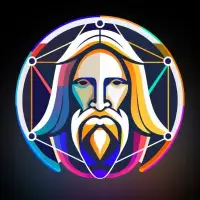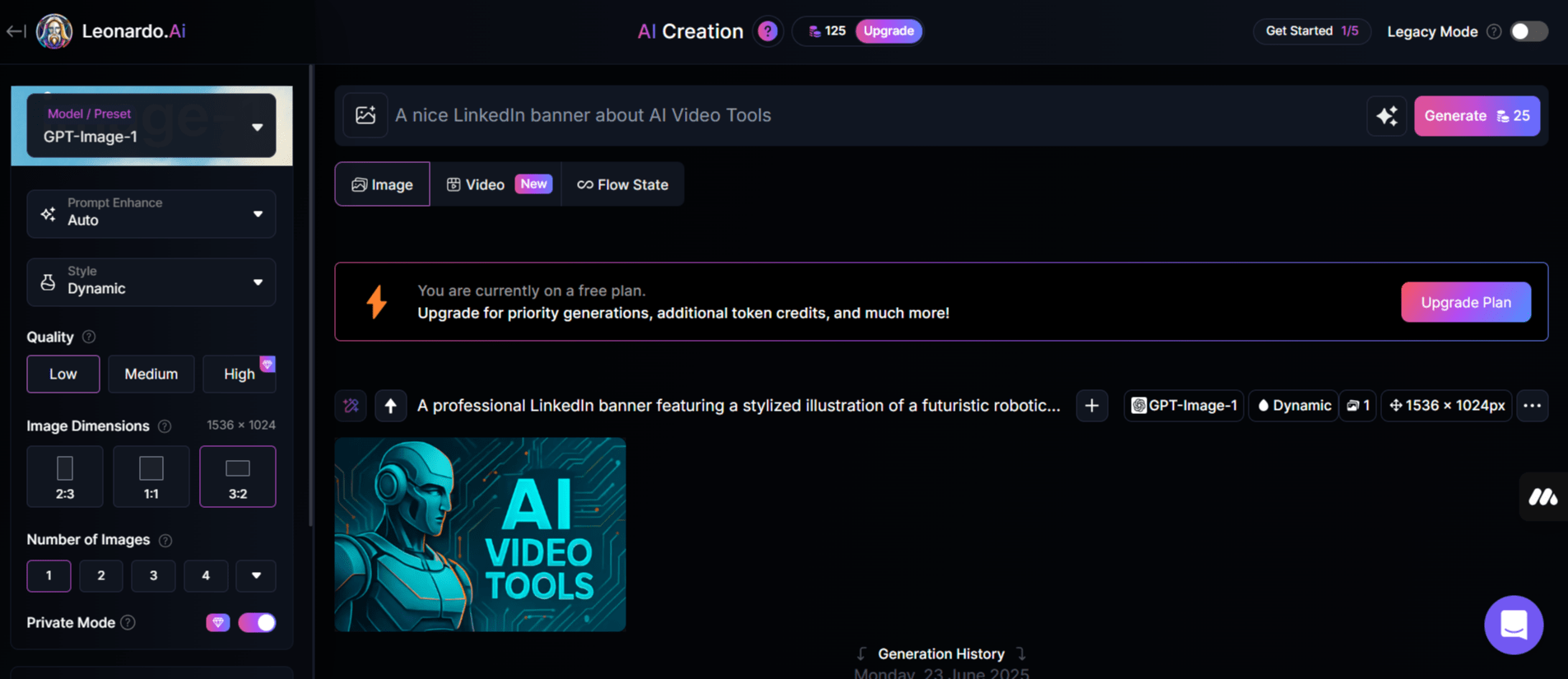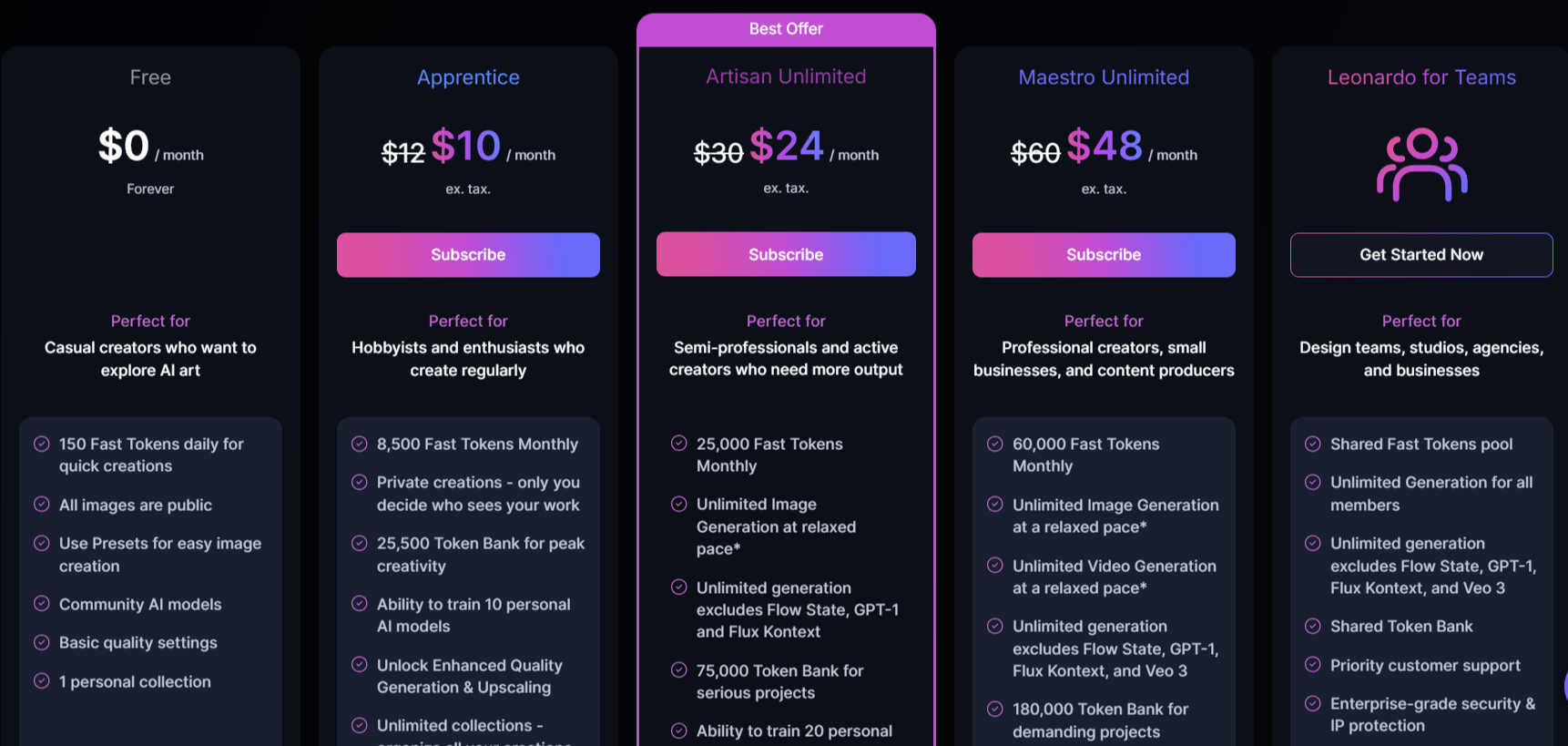Leonardo AI

Leonardo AI Origin and Growth
Leonardo AI was founded by a small Australian team in 2022 and rapidly gained popularity, surpassing many competitors. It boasts over 18 million users and the third-largest Discord community in the world. Within its first year, users generated more than 700 million images.
Core Functionality
Leonardo AI responds to text prompts to create unique, creative content.
It allows users to generate images from photorealistic landscapes to abstract designs.
The platform aims to provide granular control over the content generation process, reinforcing human creativity.

Leonardo AI Key Features
User Interface and Experience: Leonardo AI offers a sleek, intuitive, and easy-to-navigate web-based interface, allowing users to start creating in seconds. Leonardo AI is also accessible via iOS and Android smartphone apps.
Customization and Control: Users can easily adjust art style, brush strokes, output speed, image quality, and color palette.
Personalized Model Training: A standout feature is its personalized model training, enabling users to tailor the AI to their own datasets, providing unparalleled flexibility and control.
Motion (Leonardo AI Video Generator): Leonardo AI includes an Image to Motion tool, which acts as an AI video generator, turning static images into cinematic shots or short video clips.
3D Features: It supports 3D texture generation by allowing users to upload a 3D model (OBJ format) and generating detailed, realistic textures for it.
Flow State: This feature provides a continuous stream of AI-generated variations based on a prompt, allowing for quick browsing and fine-tuning. It includes a "More Like This" feature to match specific aesthetics.
Universal Upscaler: This tool increases image resolution for sharper, more detailed outputs.
Canvas Editor: Builds upon Realtime Canvas, offering tools like selection, erasing, inpainting (filling missing parts), and outpainting (expanding images) for precise adjustments.
Prompt Features
Negative Prompts: Uniquely, it allows users to specify details they don't want in their image. However, some users have reported issues with negative prompts being ignored.
AI-assisted Prompt Enhancement: This feature can write or improve prompts for more detail and specificity.
Realtime Canvas/Generation
Realtime Canvas: This allows users to start with a rough drawing, and Leonardo AI instantly improves it, adding details and turning it into a high-quality piece.
Realtime Generation: Users can see images materialize as they type their prompts, offering interactive and iterative creative processes.
Art Style and Quality
Leonardo AI image generator consistently delivers high-quality, detailed images with realistic details and vibrant colors.
The AI offers diverse style options, from photorealistic to stylized, concept art, and illustration.
Its new proprietary foundation model, Leonardo Phoenix, offers improved coherence and solutions to common AI difficulties like generating realistic hands and faces.
The image generator excels at consistent, coherent text generation within images.
Performance and Speed
Leonardo AI can generate unique images in seconds.
Premium versions allow toggling between “fast” and “quality” settings.
The Lightning XL model generates sets in under 30 seconds.
Support and Resources
Leonardo AI offers a comprehensive help center with FAQs and feature guides.
Support is available directly through an in-app messaging feature (including an AI agent for basic queries) and email.
There's an active community on Discord, Facebook, and Reddit for wisdom, feedback, and mentorship.
Leonardo AI Pricing
Leonardo AI offers several monthly subscription plans, plus a free option:
Free Plan: Provides a daily allowance of 150 tokens to generate images. Images created are public.
Apprentice Plan: Around $12 per month. Offers more tokens (e.g., 8,500), private generations, and access to more features.
Artisan Plan: For $30 per month. Provides a larger token allowance (e.g., 25,000-25,500) and potentially more simultaneous jobs.
Maestro Plan: Around $60 per month. Offers the highest token amount (e.g., 60,000) and full access to features.

Note: Token amounts and exact pricing can vary slightly based on promotions or if you choose annual billing (which often includes a discount of around 20%). It's always best to check the official Leonardo AI website for the most current details.
Leonardo AI Real-World Applications
Superside, a creative design service, uses Leonardo AI to deliver AI-enhanced creative services, generating assets like campaign images and logos, demonstrating its ability to amplify human creativity and save design time.
It's used for character design, game assets, concept art, graphic design, marketing, advertising, product photography, and more.
Pros
User-Friendly Interface: The image tool is designed to be easy to navigate, even for beginners.
Generous Free Tier: Offers a good number of daily tokens for free users to experiment with.
Custom Model Training: You can train the AI on your own images for a unique artistic style.
High-Quality Image Generation: Capable of producing detailed and often photorealistic images.
Fast Image Creation: Generates images relatively quickly.
Variety of Tools: Includes features like AI Canvas, 3D texture generation, and image-to-image.
Active Community: Users can share creations and get inspiration from others.
Good Prompt Adherence: Generally follows text prompts well, especially with features like Prompt Magic.
API Availability: Allows integration with other software for more advanced workflows.
Cons
Learning Curve for Advanced Features: Custom model training and some editing tools may require some technical know-how.
Free Plan Limitations: Images created on the free plan are public; private generations require a paid plan. Some advanced features are also be paywalled.
App Clunkiness in Some Areas: While generally user-friendly, some aspects of the user interface, like the Canvas Editor, can feel less intuitive.
Leonardo AI Comparison to Other Image Tools
When compared to Midjourney, Leonardo AI is generally considered easier to use and more customizable, making it better for branding or customer-facing projects, especially if you want accurate, flexible image generation without a steep learning curve.
Compared to Stable Diffusion, Leonardo AI offers a more user-friendly, browser-based interface, while Stable Diffusion is fully open-source and provides more flexibility for model customization and 3D depth maps.
However, some Redditors noted Leonardo AI's proprietary models are good for photographic styles, while Stable Diffusion offers more precision and control.
Frequently Asked Questions
Here are answers to some common questions about Leonardo AI, explained simply:
Can I use Leonardo AI for free?
Yes, Leonardo AI offers a free plan that gives you 150 "tokens" each day to create images.
Is Leonardo AI good for beginners?
Yes, it's designed with a user-friendly interface, making it accessible even if you don't have design skills or much art experience.
Do I own the images I create?
If you use a paid plan and generate images privately, you own the intellectual property. Images created publicly may be used by Leonardo AI and other users.
What are "models" in Leonardo AI?
Models are like different artistic styles that the AI can use. Leonardo offers various pre-trained models and allows paid users to train their own custom models.
How quickly can I create images?
Image generation is generally fast, but speed can vary based on image settings, the complexity, and the number of images you're creating at a time.
Can I sell images I make with Leonardo AI?
Yes, you can use images you generate for commercial purposes, especially if created under a paid plan with private generation.

